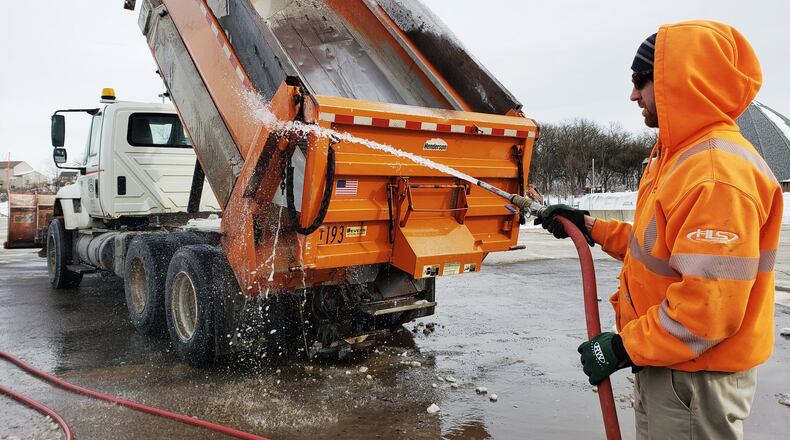Crews from the Butler County Engineer’s Office were out again Tuesday morning treating “problem areas,” said Chris Petrocy, spokesman for the department.
Petrocy said the engineer’s office budgets a certain amount for snow and ice control each winter. The amount is based on averages over the most recent 10 to 15 winters, he said.
The department starts each winter with two full salt barns, a total of 13,000 tons. In an average winter, the BCEO spreads about 6,200 tons, so the department is prepared for a “bad” winter in the event that occurs, he said.
The city of Hamilton spent nearly $200,000 in material and labor combating the two major snow storms, said James Williams, director of public works. During the two weekends, Hamilton workers spread 1,425 tons of salt and 7,405 gallons of calcium chloride and spent $51,000 in labor cost. The total costs of both events was $196,655, Williams said.
In Monroe, the total cost of the two events was $107,996, said Brian Perkins, parks and cemeteries superintendent. He said the city used 989 tons of salt, 4,000 gallons of brine mix and 2,000 gallons of beet/brine mix. The city also spent $27,662 in overtime.
He said Monroe ordered 1,000 tons of salt to restock its supply and 500 tons have been delivered.
Fairfield was still calculating the numbers from last weekend’s storm, but two weekends ago workers spread 989 tons of salt and 588 gallons of liquid treatment said Communications Manager Jenny Dexter. The storm cost the city $99,007, and 694 employee hours were used.
West Chester was expected to approve $100,000 for salt at its Tuesday night meeting, but that wasn’t in response to the recent storms, said Barb Wilson, spokeswoman. She said it’s standard for West Chester to open a purchase order around this time for the amount budgeted for 2019. The goal of an early purchase order, she said, is to gain benefit from the previous years’ pricing on salt.
Rain showers will transition to snow showers today as temperatures fall into the 30s, said Storm Center 7 Meteorologist Molly Coates. There isn’t supposed to be a significant amount of accumulation. Temperatures should be in the low 30s with partly sunny skies on Thursday, Coates said.
The winter storm kept AAA’s Roadside Rescue Team busy this weekend. Since midnight Monday, it received 442 calls for assistance from stranded drivers. Dead batteries and tire issues were the most common problems motorists faced, according to AAA spokesperson Cindy Antrican.
AAA urges motorists to practice caution with these tips for driving in the snow:
• Remove all snow from your vehicle, including the roof, hood and trunk: While driving, snow can blow off a car onto the windshield of a nearby vehicle, temporary blinding that driver’s vision.
• Slow down: Accelerate, turn and brake gradually. Adjust your speed to the road conditions and leave yourself ample room to stop. Allow at least three times more space than usual between you and the car in front of you.
• Never use cruise control on slippery roads: Patches of ice can cause unexpected wheel spin and use of cruise control can slow driver response.
• Avoid unnecessarily changing lanes: This increases the chances of hitting a patch of ice between lanes that could cause loss of vehicle control.
• Don’t tailgate: Normal following distances of three to four seconds on dry pavement should be extended to a minimum of eight to ten seconds when driving on slippery surfaces. The extra time will provide additional braking room should a sudden stop become necessary.
• Watch the traffic ahead: Slow down immediately at the sight of brake lights, fishtailing cars, sideways skids or emergency flashers ahead.
• Move over: Move over one lane for law enforcement and emergency roadside personnel assisting motorists. If you’re unable to move over, slow down.
• Carry a winter weather kit in your car: Contents should include a fully charged cell phone and car charger, ice scraper, blanket, warm winter clothing, flashlight with extra batteries, jumper cables, a bag of kitty litter, reflective triangles/flares, shovel and cloth/paper towels.
About the Author

